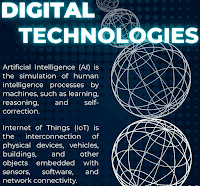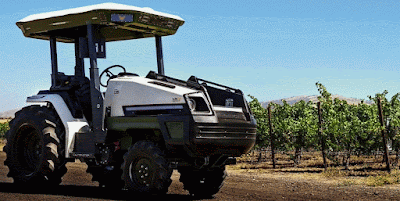AI involves the use of computers to perform tasks previously done by humans, but without immediate direct human control (sometimes called Machine Learning). So, using a spreadsheet to calculate the farm budget does not count as AI, but having a computer run your farm tractor does. The tractor’s computer program was, originally, written by a human being, of course, but after that the computer takes control of the tractor.
Given the very broad nature of the wine industry (agriculture, production, distribution, wholesale, retailing), there are lots of ways AI can get involved. So, let’s look at some of the AI involvements that have been suggested (see also: How artificial intelligence will change the world of wine, from vineyard to wine glass). A complementary idea is the Internet of Things (IoT), which refers to devices with sensors, processing ability, software and other technologies that connect and exchange data with devices and systems over the internet (or other communications networks) — it is usually a valuable complement to AI.
We’ll start with what is perceived to be the current situation and the expectations. Simone Loose, head of the Institute of Wine & Beverage at Geisenheim University, has said (Wine industry needs to professionalise to survive):
The wine industry is years behind other sectors in terms of technological advancement. Two-thirds of producers aren’t even using Excel, which means they’re not analysing their commercial business. This is a big problem ... How are wine businesses going to reach the consumer? If they’re not profitable as a business, how are they going to pay for marketing strategies? The ones who will survive are those who are the most professional.She has described how AI can help boost professional productivity, particularly when it comes to smaller producers who have yet to properly commercialize or strategize engagement with customers. Sadly, AI is currently cost-prohibitive across the supply chain for most people, except for the larger producers (small producers and Big Wine live in completely different universes!). Yet, she contends, utilizing AI in more focused areas could help make a big difference to smaller producers’ sales.
So, it has been reported that vine-growers and winemakers are, indeed, incorporating technology into their production process, as the industry faces challenges with consumer demands and the climate crisis (Vineyards embrace AI and IoT for better, tastier wine). We have often done this sort of thing in the past (eg. planting entire vineyards with a selected preferred grape-vine clone), but not always to our ultimate benefit in the modern world of changing climates (Why producers are reviving this ancient planting system).
So, I guess that we should start with the vineyard. First, here we encounter the IoT, where sensors can be installed across the vineyard. These allow viticulturists to visualize data about the relevant environmental parameters, like temperature, humidity, soil moisture, and wind speed. These parameters matter because grape-vines are perennial plants, so that each one lives for many years in the same spot, accumulating the effect of its local environment. * There is also the idea of using AI-powered robots to control vineyard pests without chemicals (Robots in the vineyards: could AI be a green winemaking solution?), by naturally disrupting the mating of those pests.
Similarly, it is reported that Monarch Tractor, for example, which is the maker of the MK-V, the world’s first fully electric, driver-optional (autonomous) smart tractor (pictured above), is expanding globally (Monarch tractor expansion across the US and Europe). This follows on from the original appearance of electric tractors themselves (First Monarch electric tractor arrives at Oregon vineyard). Moreover, using AI-robots for harvesting (grapes, apples, strawberries, etc) is actively being worked on — it seems to be only a matter of time (it was all the rage in 2020, but you don’t hear quite so much about it these days).
In the winery, we also encounter IoT sensors, which, when inside fermentation tanks, can help detect leaks, monitor the fermentation activity, and show temperature trends. Computers already control things like press cycles, fermentation temperatures, and other processes. Furthermore, AI-powered tools can be used to help wine-makers find optimal wine blends, where AI and chemistry combine to create wine-blending recipes.
When it comes to bottles, it has been reported (Greencroft Bottling: ready to offer most sustainable packaging possible) that the latest artificial intelligence technology has been integrated into some of the systems (for example, AI drives the inspection equipment on the labeling machines).
Of course, as mentioned above, the cost of the grapes, the wine-making, packaging, shipping, additional warehousing and transportation, and then the multiple layers of distribution, all need to be budgeted. This has long been where computers are very useful, and where forecasting can thus benefit from AI. This may not have much to do with wine-making, since grapes are seldom more than 10% of the total cost (Gross margins: breaking down the price of a bottle of wine).
Retailing is a whole other thing. As an example, linguistic tools such as ChatGPT have the capability to convert information on a producer’s inventory and brand into marketing or e-commerce strategies. Conversely, one of the most interesting discussions of the negative effects of AI is: The smartphone’s role in wine's decline.
When it comes to recommending wine to the wine-buying public, there are, indeed, AI-powered wine recommendation tools, which are reported to increase sales (New data shows DRINKS AI-powered personalized wine recommendations deliver surge in online wine sales). Indeed, this prompts us to ask the basic question: Can machines taste wine? The answer is currently “yes and no”; but it does prompt us to start Rethinking the role of wine professionals.
The bottom line, at the moment, is that electronic drinks recommenders are based on data from the established critics / commentators (Is AI like Chowbot coming for my wine critic job?). So, humans are still needed at this level. Indeed, it can be argued that To Save the wine industry, we’ll need a human intervention.
Conclusion
So, AI and the IoT should be helpers not replacers — we must benefit from them not rely on them. They do not allow us to work less (or not work at all), but mean that we will now work differently. AI is a tool that can make things better, but which can also be abused.
AI seems to be here to stay (EU Parliament approves the Artificial Intelligence Act), so we need to get the hang of it, and its impact. However, I am not sure that it is yet giving most of us anything that we either want or need. All it is doing is making things different.
I taught for years at several different universities, in both Australia and Sweden, and it is not sarcasm to note that Human Intelligence varies greatly among individuals. One of the great hopes of Artificial Intelligence is to try to level the playing field, so that we all get subjected to the same level of intelligence around us. Does it yet match that goal?
At the moment, my car’s computer system makes a lot of suggestions for what my driving should look like, at any given moment. However, I still do the steering, and press the accelerator and brake pedals (the clutch is automatic!). I am not sure how safe I would feel if the computer was doing the latter tasks, as well; but I and the drivers around me may actually be a lot safer if it was. **
Mind you, it was recently reported that two Indonesian airline pilots both fell asleep simultaneously on a flight (A plane flew for 28 minutes with both pilots asleep), thus relying entirely on the autopilot. They drifted off course a bit, but landed safely at their destination after they both woke up. This is AI at its best!
* The downside of being perennial is that grape-growers are loathe to pull them out (USA: Growers are pulling out grapevines — but not fast enough; Australia: Vineyards rush to sell millions of litres of wine at cut price).
** However, much of modern car technology is very expensive to maintain (The insanely high cost of tech failures in newer cars); and it also feels very much like an invasion of privacy, given how much of our personal behavior the newer cars record and permanently store (Mr Orwell, your car has arrived).




No comments:
Post a Comment